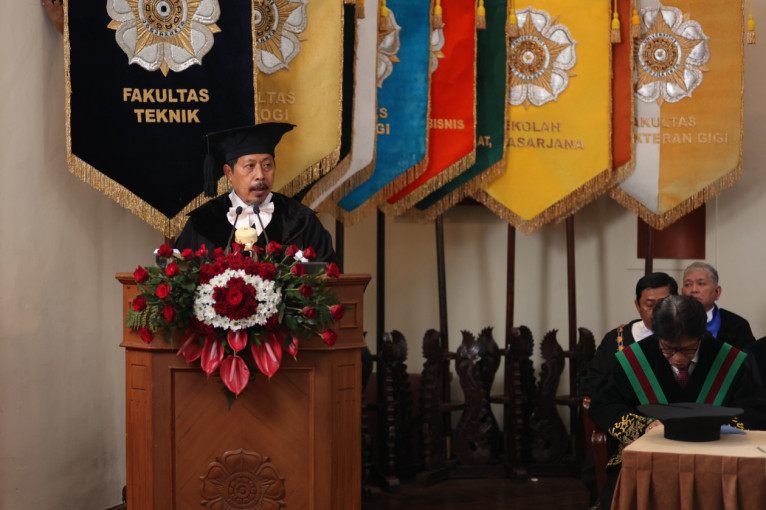
Dr. Adam Pamudji Rahardja from the UGM Faculty of Engineering has been appointed professor in civil engineering hydroinformatics.
During his inauguration on Tuesday (November 14) at the UGM Senate Hall, he delivered a speech entitled “The Role of Hydroinformatics in Efforts to Reduce Hydrometeorological Disaster Risks.”
In his speech, Professor Rahardja highlighted the importance of hydroinformatics in mitigating the risks of hydrometeorological disasters, particularly flash floods. He emphasized that flash floods are common in Indonesia, affecting various major islands and causing significant damage to public facilities, individual buildings, and human lives.
Flash floods are characterized by their rapid and sudden onset, making them particularly destructive. He outlined several mitigation strategies, both physical and non-physical, that can be implemented to reduce the risk of flash flood disasters.
“To reduce the risk of losses due to damage to public facilities, individual buildings, and loss of life, there are several mitigation efforts that can be done, both physical and non-physical,” said the Civil and Environmental Engineering Department lecturer.
Physical efforts, he continued, can be made by constructing specific facilities. These facilities aim to reduce the speed of flash flood flow, retain sediment material, and protect vulnerable infrastructure from flood damage. Examples include cliff protectors, pillar protectors, and bridge abutments.
As for non-physical efforts, they can be made by adapting to the flash flood phenomena faced. Adaptation involves utilizing land that accommodates flood events and preparing to avoid them when they occur.
Examples include spatial adaptation, the creation of evacuation routes and places, and the development of early warning systems for flash floods.
In designing water structures to reduce disaster risks due to flash floods or lahar floods, such as decreasing slope with a series of dams, spatial-temporal data on rainfall and floods are needed to determine the sizes and specifications of the structures according to applicable design standards.
The existence and quality of data and the analysis of the designed flood simulation will increase the reliability of the physical water infrastructure planning.
Non-physical mitigation efforts for flash floods include disaster mitigation policies, spatial planning, introduction of disaster threats, disaster preparedness training, evacuation simulations, and flash flood early warning systems.
He provided several recommendations for enhancing the role of hydroinformatics in reducing the risk of flash flood disasters. One of them is the implementation of policies that support the monitoring of hydrometeorological parameters.
These parameters include river flow to serve the community at the micro level, especially those vulnerable to flash floods.
In the short and medium term, investments in the procurement, operation, and maintenance of monitoring equipment are conducted by authorized regional agencies to ensure its functionality.
Regional agencies should increase their capacity in data analysis for physical and non-physical mitigation and efforts to identify and map communities vulnerable to flash floods. They should also provide flash flood preparedness information to vulnerable communities at the regional and village levels.
“The development of science and technology based on data that supports the reduction of flash flood disaster risks needs to be encouraged,” he added.
In the long run, the central government can facilitate the monitoring of hydrometeorological conditions with short-range, more accurate rain radar technology (X-Band) throughout vulnerable areas. This needs to be followed by an early warning system, including increasing public capacity.
“An information system for monitoring the condition of flood control structures such as flood control dams, sediment control dams, consolidation dams, riverbank retaining walls, abutments, and bridge pillars also needs to be established, operated, and maintained for their sustainability,” he concluded.
Author: Ika
Photographer: Firsto

